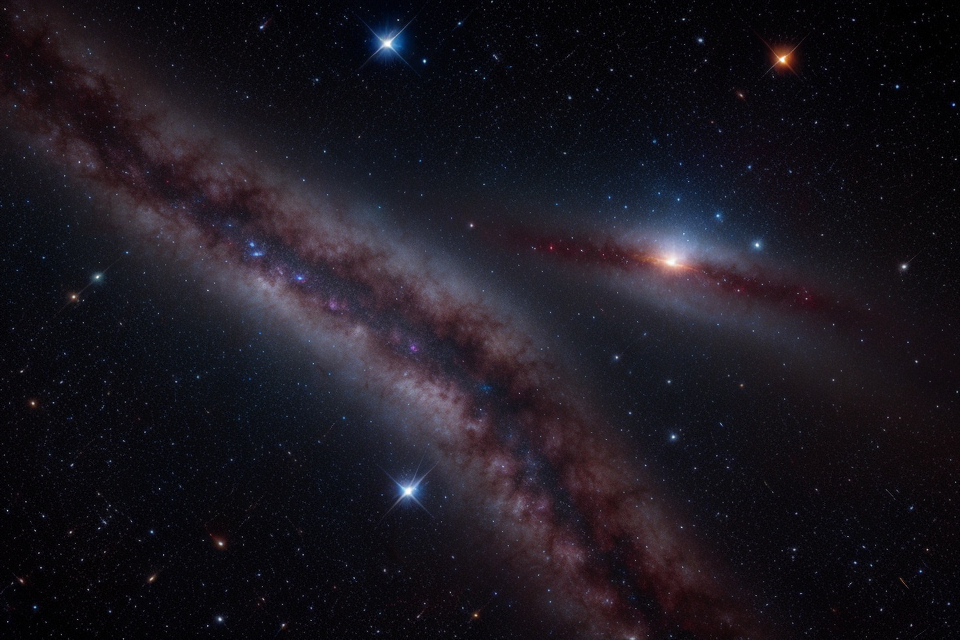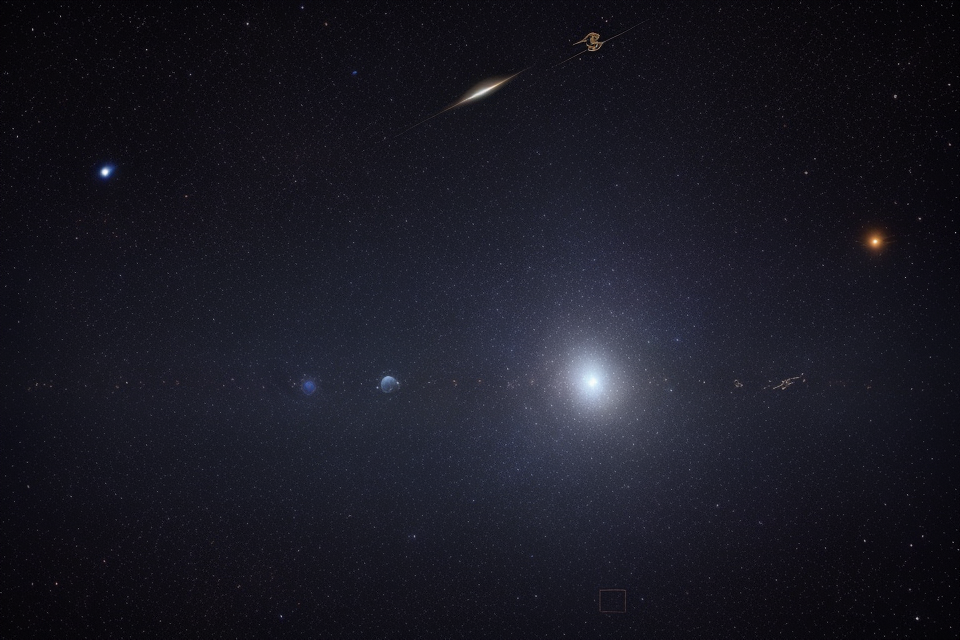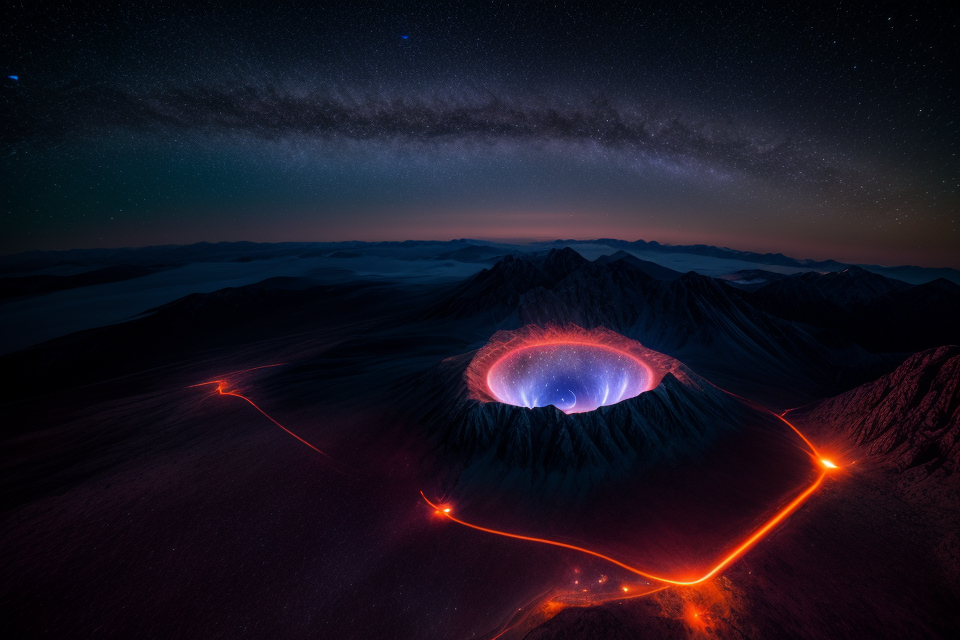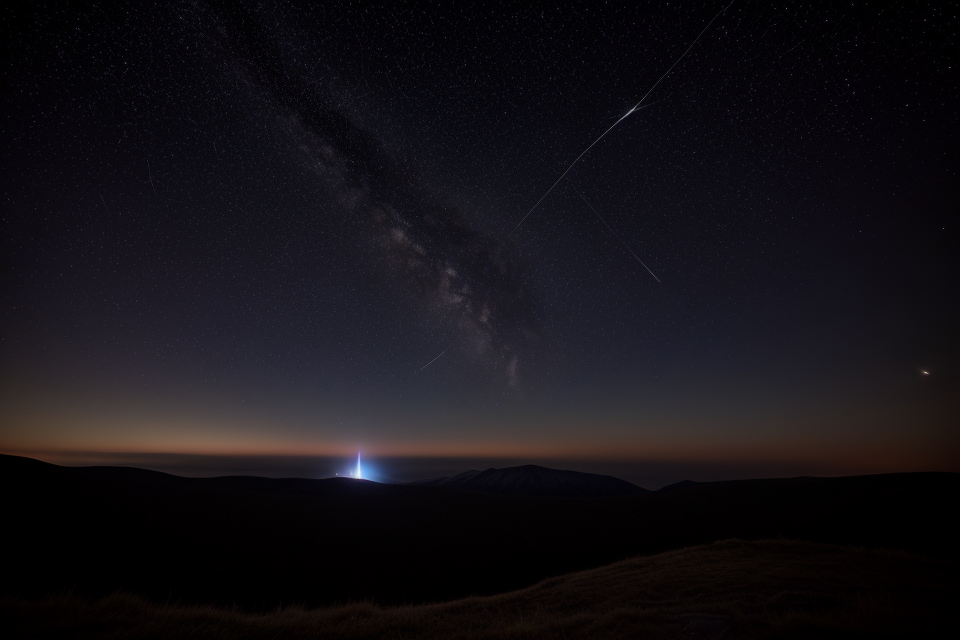The universe is full of wonders, and one of the most fascinating aspects of it is the rare astronomical events that take place. These events are so rare that they occur only once in a blue moon, and some of them have never been witnessed before. In this article, we will delve into the rarest astronomical event known to mankind and explore the science behind it. Get ready to be amazed as we unveil the secrets of the cosmos and discover what makes this event so unique. So, fasten your seatbelts and get ready for a journey through the universe like never before!
The Elusive Nature of Rare Astronomical Events
Factors Affecting Rarity
Rare astronomical events are elusive because they occur infrequently, making them difficult to observe and study. There are several factors that contribute to the rarity of these events, including:
- Cosmic scales: Astronomical events occur on cosmic scales, making them difficult to observe with current technology. Even with advanced telescopes, observing these events can be challenging due to the vast distances involved.
- Unpredictable nature: Astronomical events are often unpredictable, making them difficult to plan for. While some events can be predicted with reasonable accuracy, others can occur suddenly and without warning.
- Planetary alignment: The position of the planets relative to each other can affect the occurrence of astronomical events. For example, the alignment of the planets can cause gravitational interactions that can lead to rare astronomical events.
- Solar activity: The sun’s activity can also affect the occurrence of rare astronomical events. For example, solar flares and coronal mass ejections can disrupt the Earth’s magnetic field, causing aurorae to appear in locations outside the polar regions.
- Atmospheric conditions: Atmospheric conditions on Earth can also affect the observation of rare astronomical events. For example, cloud cover, pollution, and light pollution can all make it difficult to observe rare astronomical events.
Overall, the rarity of astronomical events is a complex issue that involves a range of factors. By understanding these factors, scientists can develop better techniques for observing and studying these events, helping to unlock new insights into the universe.
Examples of Rare Astronomical Events
- Occurrence and Observability
a. Gravitational Waves: Ripples in space-time caused by the acceleration of massive objects, such as black holes or neutron stars. Detectable only through highly sensitive instruments.
b. Gamma-Ray Bursts: Intense and short-lived bursts of high-energy radiation from distant galaxies. Observing these events requires specialized space-based telescopes.
c. Novae: Sudden increases in brightness of a star due to a thermonuclear explosion on its surface. These events are often hidden behind thick layers of dust and gas, making them difficult to observe.
2. Solar Phenomena
a. Solar Eclipses: The alignment of the Sun, Earth, and Moon resulting in the temporary obscuration of the Sun’s light. Totality during a solar eclipse is a rare sight, with the duration ranging from seconds to minutes.
b. Sunspot Cycles: The periodic changes in the Sun’s magnetic activity, which can affect the Earth’s climate and technology. These cycles last approximately 11 years and can be observed through specialized telescopes.
3. Stellar Phenomena
a. Supernovae: The violent deaths of massive stars, either as a supernova explosion or as a red giant. These events are rare and fleeting, often occurring in distant galaxies.
b. Neutron Stars and Pulsars: Extremely dense remnants of massive stars, detected through their intense electromagnetic emissions or the pulses of radiation they emit.
c. Binary Star Systems: Particularly close binary star systems, where the stars orbit each other in a short period. These systems can lead to unique astronomical events, such as stellar mergers or the formation of exotic objects like neutron stars or black holes.
The Most Rare of Them All: The Eternal Eclipse
Description of an Eternal Eclipse
An eternal eclipse, a phenomenon that occurs when a celestial body comes between the Earth and the Sun, completely blocking the sunlight, resulting in an unusually long and dark period of time. The term “eternal” refers to the duration of the eclipse, which can last for several days or even weeks, making it one of the rarest astronomical events.
An eternal eclipse occurs when the Earth, the Moon, and the Sun are aligned in a straight line, with the Earth at the center of the line. The Moon, which is farther from the Earth than the Sun, blocks the sunlight from reaching the Earth, resulting in a total solar eclipse. However, unlike a typical solar eclipse, which lasts only a few minutes to a few hours, an eternal eclipse can last for several days or even weeks.
During an eternal eclipse, the sky becomes dark, and the stars become visible in the daytime. The duration of the eclipse depends on the positions and movements of the celestial bodies, as well as the observer’s location on the Earth. The eclipse can last for several days or even weeks, depending on the observer’s location on the Earth and the positions and movements of the celestial bodies.
An eternal eclipse is a rare event that occurs only once or twice in a century. The last recorded eternal eclipse occurred in 1918, and the next one is expected to occur in 2091. The duration of the eclipse varies depending on the observer’s location on the Earth, and the exact duration can only be determined after the eclipse has occurred.
Overall, an eternal eclipse is a rare and fascinating astronomical event that occurs only occasionally. It offers a unique opportunity to observe the sky and study the positions and movements of the celestial bodies.
The Significance of an Eternal Eclipse
An Eternal Eclipse, also known as an ‘eternal’ or ‘total’ solar eclipse, is a rare astronomical event that occurs when the Moon comes between the Earth and the Sun, casting a shadow on the Earth. This phenomenon is significant for several reasons, as it allows scientists to study the Sun’s atmosphere, known as the corona, in greater detail. The corona is typically hidden from view by the bright surface of the Sun, but during an Eternal Eclipse, the Moon’s shadow blocks out the Sun’s light, revealing the delicate structure of the corona.
Additionally, Eternal Eclipses provide a unique opportunity for astronomers to study the Sun’s magnetic field, which is essential for understanding the Sun’s role in the solar system and its impact on the Earth. By studying the magnetic field of the Sun during an Eternal Eclipse, scientists can gain a better understanding of the Sun’s activity and the potential impact it may have on the Earth’s environment.
Moreover, Eternal Eclipses are also culturally significant, as they have been observed and celebrated by civilizations throughout history. From ancient cultures to modern societies, Eternal Eclipses have been seen as omens of change and transformation, and have been the subject of myths, legends, and folklore. In many cultures, Eternal Eclipses were seen as divine signs, and were often associated with important events, such as the birth or death of important figures.
In conclusion, the significance of an Eternal Eclipse lies in its scientific, cultural, and historical importance. It provides a unique opportunity for scientists to study the Sun and its atmosphere, and has been observed and celebrated by civilizations throughout history. As such, Eternal Eclipses continue to captivate and inspire people around the world, and remain a fascinating subject of study and wonder.
Understanding the Science Behind the Rarest Astronomical Event
Gravitational Lensing
Gravitational lensing is a phenomenon in which the gravitational field of a massive object bends and warps the light emitted by a more distant object, causing it to appear distorted or magnified. This phenomenon was first predicted by Albert Einstein’s theory of general relativity, which describes how gravity operates on a macroscopic scale.
Gravitational lensing occurs when a massive object, such as a galaxy or a cluster of galaxies, sits between an observer and a more distant object, such as a star or a galaxy. The massive object’s gravity causes the light from the more distant object to bend and warp, creating a magnified or distorted image. This effect is similar to the way a glass lens can bend and magnify light.
One of the most interesting aspects of gravitational lensing is that it allows astronomers to study the distribution of mass in distant objects. By analyzing the amount of distortion in the light of a distant object, astronomers can infer the presence of mass and the structure of the lensing object. This can provide insights into the composition and evolution of galaxies and other large-scale structures in the universe.
Gravitational lensing is also an important tool for studying the properties of dark matter, which is thought to make up about 85% of the matter in the universe. Dark matter does not interact with light or other forms of electromagnetic radiation, so it is difficult to study directly. However, by analyzing the way that dark matter affects the distribution of mass in a lensing object, astronomers can learn more about its properties and role in the universe.
Overall, gravitational lensing is a powerful tool for studying the universe on a macroscopic scale, allowing astronomers to probe the distribution of mass and the properties of dark matter in ways that would be impossible with other methods. By understanding this phenomenon, scientists can gain new insights into the nature of the universe and the forces that shape it.
Black Hole Collisions
The merger of two black holes is a highly intriguing and rare astronomical event. Black holes, as the name suggests, are regions of spacetime where gravity pulls so strongly that nothing, not even light, can escape. They form when a massive star dies and its matter collapses in on itself. When two black holes orbit each other, they inevitably collide due to the gravitational force that draws them together. This cosmic crash produces a catastrophic release of energy in the form of gravitational waves.
- Gravitational waves are ripples in spacetime that propagate across the universe at the speed of light. They were first predicted by Albert Einstein’s theory of general relativity and were detected directly for the first time in 2015 by the Laser Interferometer Gravitational-Wave Observatory (LIGO). The detection of gravitational waves marked a new era in astronomy, enabling scientists to study the universe in a way previously thought impossible.
The collision of two black holes is so rare because black holes themselves are rare. Most stars in the universe do not end their lives as black holes, but instead form neutron stars or explode in supernovae. The formation of black holes also depends on the mass of the original star. Black holes are formed when a star with a mass of at least three times that of our sun collapses. Furthermore, the likelihood of two black holes with similar masses and orbits colliding is quite low, as the universe is vast and the probability of two black holes coming together is incredibly small.
However, black hole collisions are becoming more detectable as technology improves. Advanced Laser Interferometer Gravitational-Wave Observatory (aLIGO) and Virgo, two next-generation gravitational wave detectors, have greatly increased the sensitivity and range of detection. As a result, scientists have detected multiple black hole collisions since 2015, providing invaluable insights into the nature of these enigmatic objects and the universe itself.
Observing the Rarest Astronomical Event: Challenges and Opportunities
Detection Techniques
Detecting rare astronomical events is a challenging task, but advancements in technology have made it possible to observe them in greater detail. Some of the techniques used for detecting these events include:
Photometry
Photometry is the measurement of the brightness of celestial objects. It is used to detect changes in brightness that occur during rare astronomical events. Photometry is usually done using telescopes equipped with cameras or photometers. These instruments can detect small changes in brightness that would be impossible for the human eye to observe.
Spectroscopy
Spectroscopy is the analysis of the spectrum of light emitted by celestial objects. It is used to detect changes in the composition of the object during rare astronomical events. Spectroscopy can reveal information about the temperature, density, and velocity of the object, which can provide insights into the nature of the event.
Polarimetry
Polarimetry is the measurement of the polarization of light emitted by celestial objects. It is used to detect changes in the orientation of the object’s magnetic field during rare astronomical events. Polarimetry can provide information about the strength and direction of the magnetic field, which can help scientists understand the physical processes occurring during the event.
Radio Astronomy
Radio astronomy is the study of celestial objects using radio waves. It is used to detect rare astronomical events that emit radio waves, such as pulsars and quasars. Radio telescopes can detect faint radio signals that are not visible to the human eye, providing valuable information about the nature of the event.
These detection techniques, combined with advanced analytical methods, allow scientists to study rare astronomical events in greater detail than ever before. The insights gained from these observations can help us better understand the universe and the physical processes that govern it.
Future Observational Prospects
While the observations of the rarest astronomical event have been challenging, the future holds great promise for more extensive and detailed observations. Here are some of the future observational prospects that scientists are excited about:
- Improved Observational Techniques: As technology advances, scientists are developing new observational techniques that will enable them to study the rarest astronomical event in greater detail. For example, new space-based telescopes such as the James Webb Space Telescope will be able to observe the event in infrared wavelengths, providing a clearer picture of the event’s physical properties.
- Collaborative Observations: Scientists are increasingly collaborating across borders and disciplines to observe the rarest astronomical event. This collaboration brings together expertise from different fields, such as astrophysics, cosmology, and data analysis, to provide a more comprehensive understanding of the event.
- Ground-based Observatories: Ground-based observatories such as the Large Synoptic Survey Telescope (LSST) will be able to observe the rarest astronomical event in greater detail. The LSST will have a wider field of view than previous telescopes, allowing scientists to observe a larger area of the sky and potentially detect more instances of the event.
- Simulation and Modeling: Scientists are also using simulation and modeling techniques to better understand the rarest astronomical event. By simulating the event and comparing the results to observed data, scientists can develop more accurate models of the event and gain insights into its physical properties.
Overall, the future holds great promise for observing the rarest astronomical event. With new observational techniques, collaborative observations, ground-based observatories, and simulation and modeling, scientists are eager to learn more about this fascinating event and its impact on our understanding of the universe.
Impact of the Rarest Astronomical Event on Astrophysics and Cosmology
Advancements in Our Understanding of the Universe
The study of the rarest astronomical event has provided significant advancements in our understanding of the universe. Some of these advancements include:
Refinement of Cosmological Models
The observation of the rarest astronomical event has allowed scientists to refine their cosmological models. By studying the properties of the event, such as its luminosity and duration, researchers have been able to better understand the nature of dark matter and dark energy, which make up most of the universe.
Discovery of New Phenomena
The rarest astronomical event has also led to the discovery of new phenomena in the universe. For example, the detection of gravitational waves from the event has provided insights into the behavior of black holes and neutron stars. Additionally, the study of the event’s electromagnetic radiation has revealed new information about the processes that occur in the cores of dying stars.
Improved Observational Techniques
Finally, the study of the rarest astronomical event has led to the development of improved observational techniques. The observations of the event required the use of advanced telescopes and instruments, which have since been used to study other celestial objects. These improved techniques have allowed scientists to observe the universe in greater detail than ever before, leading to new discoveries and insights into the nature of the universe.
The Search for Additional Rare Events
- Exploring the Depths of Cosmic Phenomena: A Journey Beyond the Known
- Probing the Limits of Gravitational Waves
- Investigating the High-Frequency Frontier
- Pushing the Boundaries of Electromagnetic Waves
- Seeking Out Dark Matter’s Elusive Nature
- The Quest for Direct Detection
- Indirect Detection: The Hunt for Traces in Cosmic Rays
- The Hunt for Exotic Particles: Searching for Beyond the Standard Model
- Axion Hunting: Seeking a Solution to the Strong CP Problem
- WIMPs and Beyond: Exploring the Dark Sector of Physics
- Probing the Limits of Gravitational Waves
- Navigating the Uncharted Territory of Multi-Messenger Astronomy
- Combining Forces: Bridging the Gap Between Observatories
- Integrating Data from Gravitational Wave Detectors
- Combining Insights from Neutrino and Cosmic Ray Observatories
- Unveiling the Full Spectrum of Astrophysical Phenomena
- Studying Cosmic Accelerators: Gamma-Ray Bursts and Jets
- The Interplay Between Neutrinos and Gravitational Waves
- Exploring the Interconnectedness of the Universe
- The Web of Cosmic Connections: Pulsar Timing and Gravitational Waves
- Unraveling the Mysteries of Cosmic Structures with Galaxy Surveys
- Combining Forces: Bridging the Gap Between Observatories
- Expanding the Horizons of Astrophysics and Cosmology: A Global Effort
- International Collaborations: Building a Global Network of Observatories
- The Global Network of Gravitational-Wave Observatories
- Collaborative Efforts in Neutrino Astronomy
- The Role of Citizen Science in the Quest for Rare Events
- Engaging the Public in the Search for Novel Phenomena
- The Potential of Crowdsourcing in Astronomy
- Training the Next Generation of Astrophysicists and Cosmologists
- Educational Programs and Outreach in Multi-Messenger Astronomy
- Preparing the Future Workforce for the Exciting Frontiers of Research
- International Collaborations: Building a Global Network of Observatories
Reflections on the Elusive Nature of Rare Events
Rare astronomical events, by their very nature, elude capture and observation, leaving astronomers and astrophysicists grappling with the uncertainty of their occurrence. These fleeting phenomena often require precise and protracted observations, necessitating extensive planning and coordination among various research institutions and telescopes.
Moreover, the rarity of these events renders them difficult to study in depth, as the paucity of occurrences limits the amount of data that can be collected. This limitation often necessitates the employment of sophisticated statistical methods and theoretical models to draw meaningful conclusions from the meager available data.
Despite these challenges, the pursuit of rare astronomical events remains a crucial aspect of astrophysics and cosmology, as these events often provide unique insights into the workings of the universe. The elusive nature of these phenomena, therefore, serves as both a challenge and a motivation for researchers to develop innovative observational strategies and theoretical frameworks to better understand the universe and its underlying processes.
The Excitement of Future Discoveries
The upcoming rare astronomical event has stirred the astrophysics and cosmology communities with a palpable sense of anticipation. The excitement stems from the potential for groundbreaking discoveries that could reshape our understanding of the universe. Some of the most intriguing possibilities include:
- Dark Matter Detection: This event may provide an unprecedented opportunity to detect elusive dark matter particles. The enhanced gravitational field created by the astronomical alignment could result in increased interactions between dark matter and regular matter, leaving detectable signatures.
- Gravitational Wave Detection: The rare event may generate stronger gravitational waves than usual, offering a chance to observe these fleeting ripples in space-time with greater precision. Improved gravitational wave detection capabilities could offer new insights into the nature of black holes, neutron stars, and other extreme astrophysical phenomena.
- Multimessenger Astronomy: The convergence of different astronomical phenomena during the rare event might allow scientists to study the universe using multiple messengers (e.g., electromagnetic radiation, gravitational waves, and neutrinos) simultaneously. This approach could yield a more comprehensive understanding of the universe and its underlying principles.
- Astrobiology and Exoplanet Studies: The unique astronomical conditions created by the rare event might offer a chance to study the habitability of exoplanets or detect biosignatures on other worlds. This information could be crucial for understanding the conditions necessary for life to exist elsewhere in the universe.
- Cosmic Inflation Studies: The rare event might provide new insights into the early universe’s expansion, a period known as cosmic inflation. A better understanding of this epoch could help answer fundamental questions about the universe’s origins and its large-scale structure.
As scientists and researchers prepare to observe the rare astronomical event, the excitement surrounding its potential implications for astrophysics and cosmology continues to grow. The future discoveries that may stem from this event could reshape our understanding of the universe and fuel new areas of research for years to come.
FAQs
1. What is the rarest astronomical event?
The rarest astronomical event is a supermassive black hole merger. This event occurs when two supermassive black holes, each containing millions of times the mass of our sun, come together in a collision that produces a tremendous amount of energy. These mergers are extremely rare, occurring only once every few decades, and are incredibly difficult to observe because they happen in the centers of galaxies, which are very far away from Earth.
2. How do scientists detect a supermassive black hole merger?
Scientists detect supermassive black hole mergers through a variety of methods, including the detection of gravitational waves, which are ripples in space-time caused by the acceleration of massive objects, and the observation of electromagnetic radiation, such as X-rays and gamma rays, that are produced when the merging black holes are heated to incredibly high temperatures. These observations can provide scientists with valuable information about the properties of black holes and the universe as a whole.
3. Why are supermassive black hole mergers important for our understanding of the universe?
Supermassive black hole mergers are important for our understanding of the universe because they provide insights into the properties of black holes and the evolution of galaxies. The mergers can also be used to test theories about the behavior of gravity, such as Einstein’s theory of general relativity, which predicts the existence of gravitational waves. Additionally, the energy released during a supermassive black hole merger can influence the evolution of the host galaxy and its surroundings, providing clues about the history of the universe.
4. How often do supermassive black hole mergers occur?
Supermassive black hole mergers are extremely rare events that occur only once every few decades. This is because the galaxies that contain the black holes are very far away from each other, and it takes a long time for them to move close enough for the black holes to merge. Additionally, the probability of two supermassive black holes merging is dependent on the properties of the galaxies and the black holes themselves, making the event even more rare.
5. What are some of the challenges in studying supermassive black hole mergers?
Studying supermassive black hole mergers is a challenging task because the events happen very far away from Earth and are difficult to observe directly. The observations are often made through the detection of gravitational waves, which are extremely weak and difficult to detect. Additionally, the high-energy radiation produced during a supermassive black hole merger can be difficult to detect and requires specialized instruments to detect. The rarity of the event also means that there are few opportunities to study the phenomenon, making it difficult to gain a complete understanding of the event.



